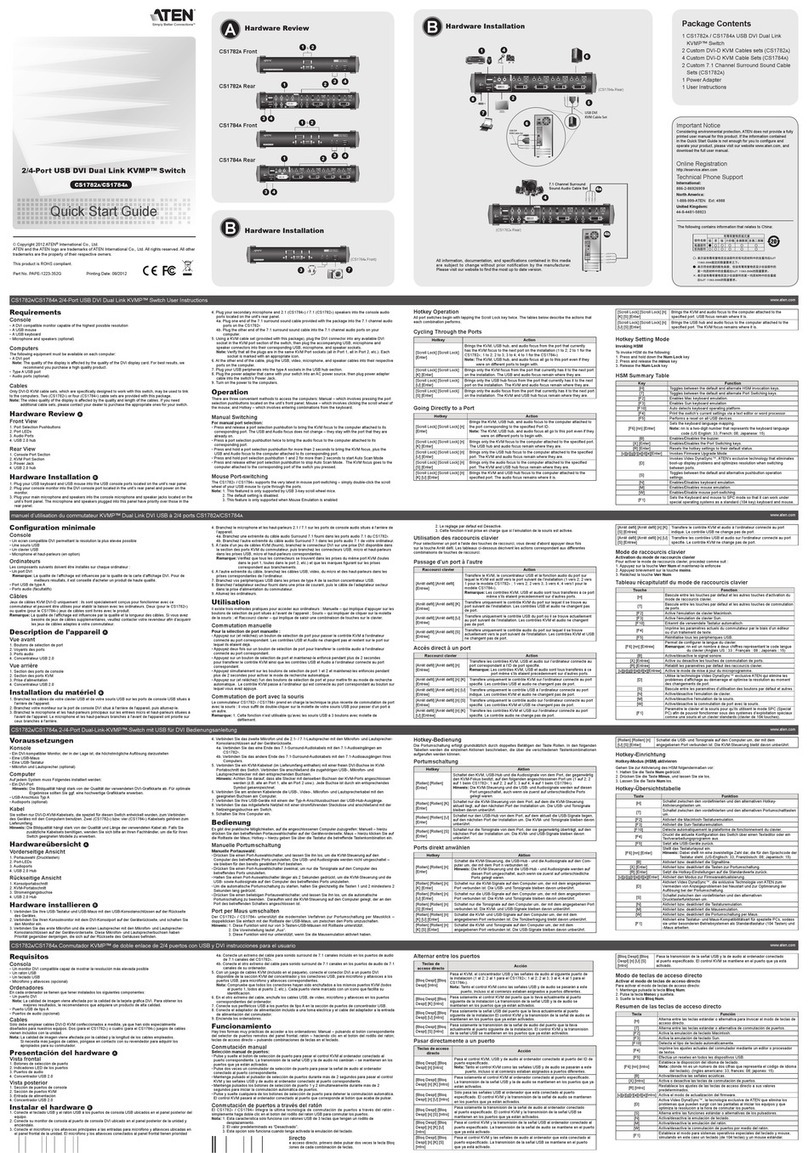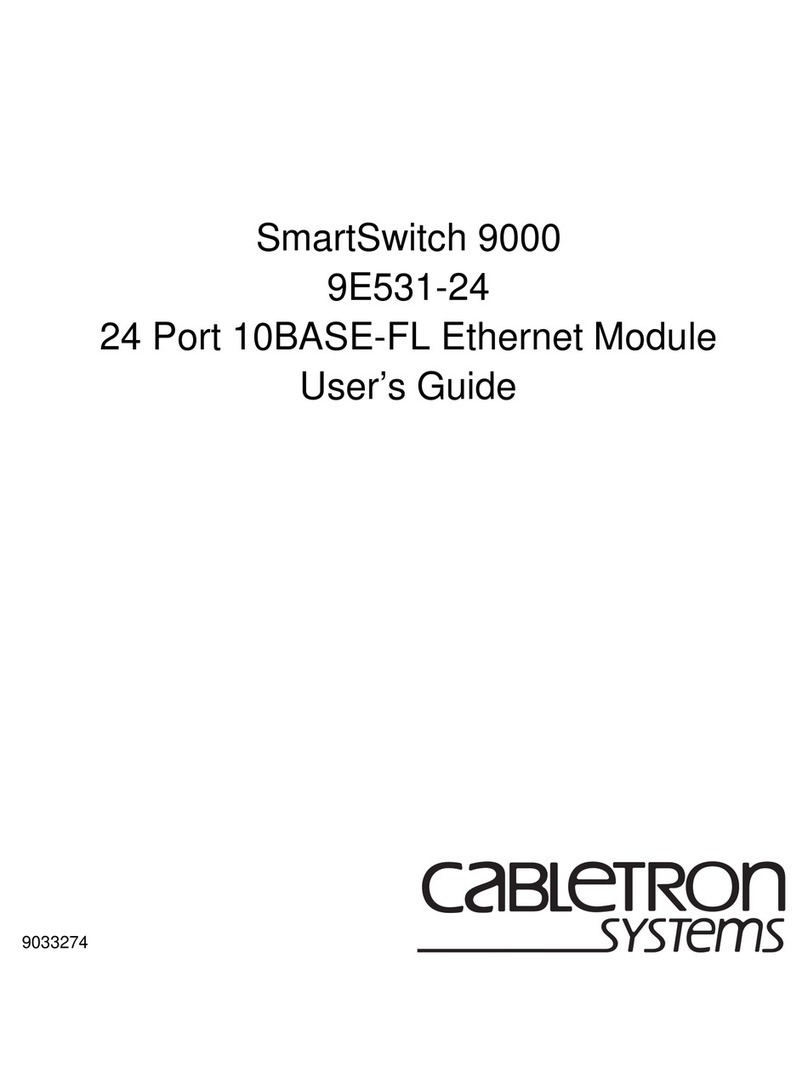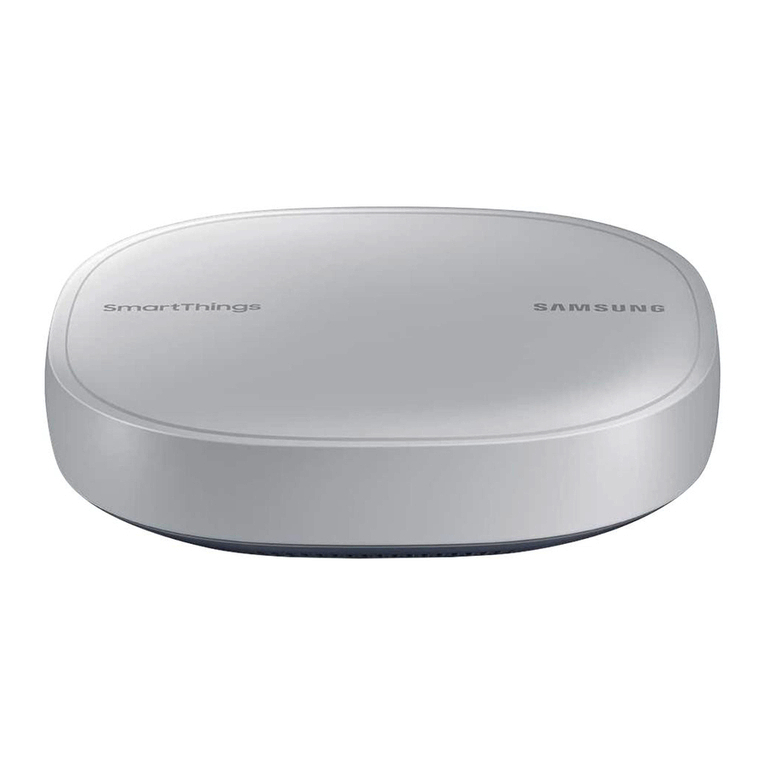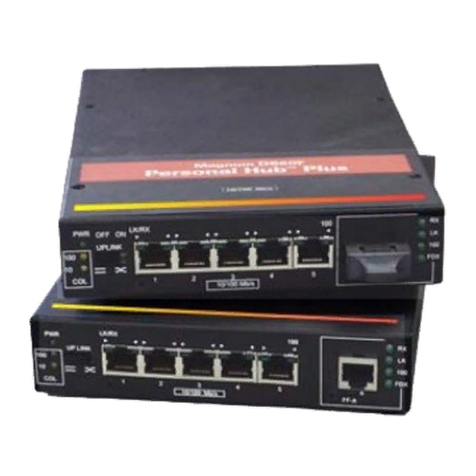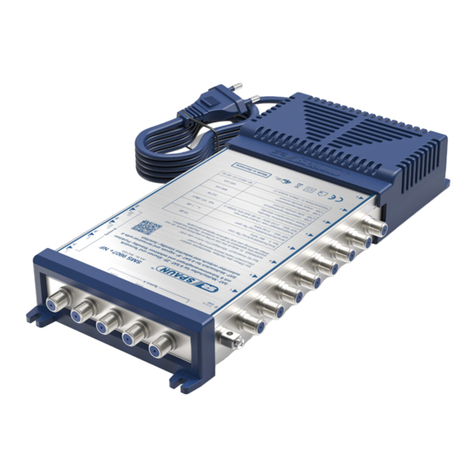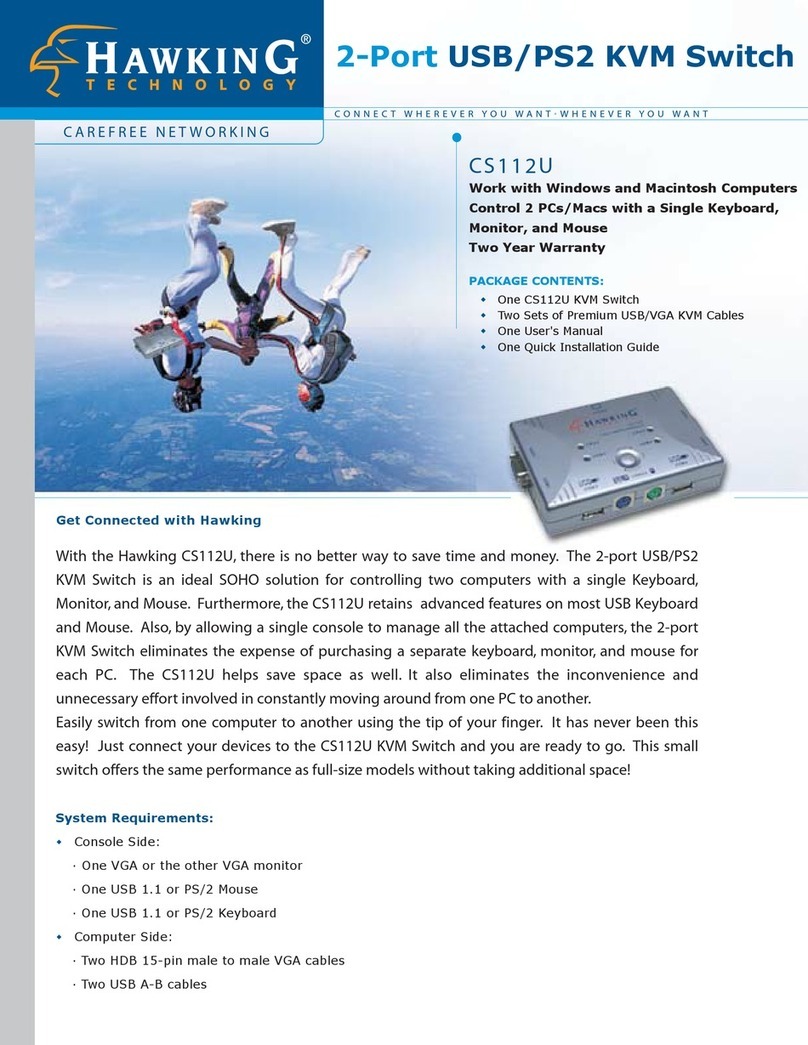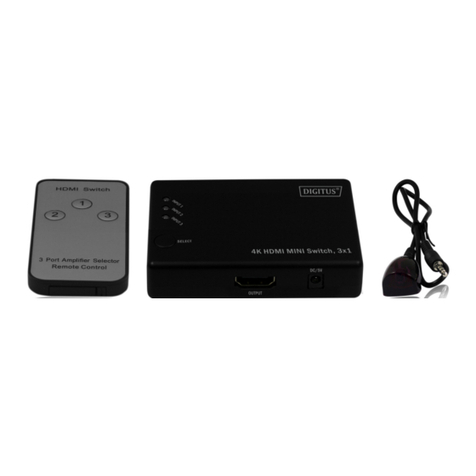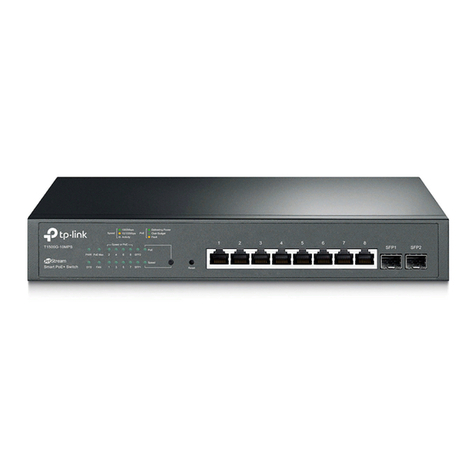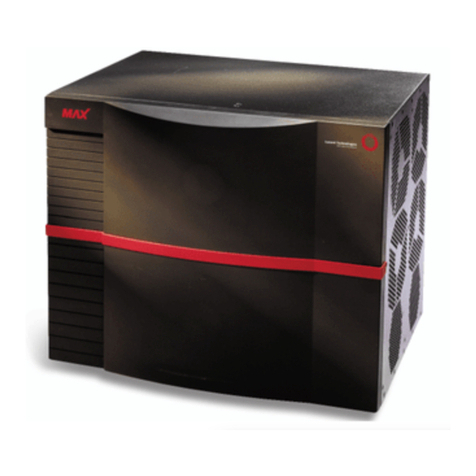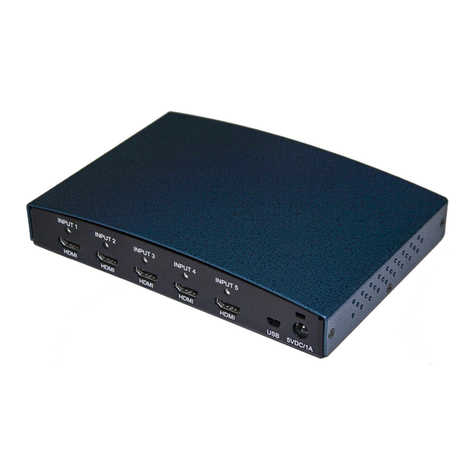Dicon VX500 User manual

91500 Revision B
VX500
Fiberoptic Switch
Operation Manual

91500 Revision B
2 DiCon Fiberoptics VX500 Fiberoptic Switch
Copyright © 1998 DiCon Fiberoptics, Incorporated.
All rights reserved. Printed in the United States of America.
No part of this manual may be reproduced, in any form or by any means, electronic or
mechanical, including photocopying, without the express written permission of DiCon
Fiberoptics.
We have reason to believe that a number of the company and product names appearing
herein constitute trademarks or have been designated as such by their respective holders.
No attempt has been made to designate these words as trademarks or as registered trade-
marks. The inclusion, or exclusion of a word or term is not intended to affect, or express a
judgment on, the validity or legal status of the word or term as a trademark, or other propri-
etary term.
The information provided within this manual has been carefully reviewed for technical accu-
racy. DiCon Fiberoptics reserves the right to correct technical or typographical errors at any
time, without prior notice. In no event shall DiCon Fiberoptics be liable for errors contained
herein, or for incidental or consequential damages arising out of or related to, this docu-
ment or the information contained in it.
Warranty
DiCon Fiberoptics warrants this product to be free from defects in both workmanship and
performance for a period of one year from the time of original shipment. During the war-
ranty period, DiCon Fiberoptics will, at its option, repair or replace any material found to be
defective.
The foregoing warranty extends to all cases, except where the product has been damaged
through misuse, mishandling, inadequate maintenance, owner modification, failure to fol-
low the installation and operating instructions provided by DiCon Fiberoptics, flood, fire or
other events outside our reasonable control.
EXCEPT AS SPECIFIED HEREIN, DICON FIBEROPTICS MAKES NO OTHER WAR-
RANTIES, EXPRESSED OR IMPLIED, INCLUDING BUT NOT LIMITED TO, THE
IMPLIED WARRANTIES OF MERCHANTABILITY AND FITNESS FOR A PARTICULAR
PURPOSE.DICONFIBEROPTICSSHALLNOT BELIABLEFORDAMAGESRESULTING
FROM LOSS OF DATA, PROFITS, USE OF PRODUCTS, OR INCIDENTAL OR CONSE-
QUENTIAL DAMAGES. This limitation of the liability of DiCon Fiberoptics will apply regard-
less of the form of action whether based on contract, tort, or any other legal theory.
All Returns
Contact DiCon Fiberoptics before returning any product.
DiCon will provide a Return
Material Authorization (RMA) number and shipping instructions. No product will be
accepted for return without an RMA number clearly marked on the outside of the shipping
material.
Any unit that is returned under warranty, but for which evidence of misuse or mishandling is
found, will be subject to testing and processing fees, in addition to any repair costs.
DiCon Fiberoptics will cover anyfreight costs for returning warranty returned material to the
customer. The customer is responsible for covering any freight costs for sending materials
to DiCon Fiberoptics. The customer is responsible for all freight costs for returned materials
found to be out of warranty.
Use the original packing materials when returning material to DiCon Fiberoptics. If the orig-
inal packing materials are unavailable, the customer is responsible for ensuring adequate
packing materials are used to prevent damage during shipping.

October 20, 1998
3
Contents
Product Overview ....................................................................................................... 5
Optical Switch Module ............................................................................................... 5
VX500 Interface Board .............................................................................................. 5
Connecting to the Interface ................................................................................. 6
Reading the Status LED ............................................................................................ 6
Thermal Considerations ............................................................................................. 6
Switch Operation ........................................................................................................ 7
Starting the Switch ..................................................................................................... 7
Resetting the Switch .................................................................................................. 7
Losing Power to the Switch ....................................................................................... 8
Selecting an Output Channel ..................................................................................... 8
Simplex 1 × N Configurations .............................................................................. 8
Synchronous Duplex 1 × N Configurations ....................................................... 10
2×N Non-Blocking Configurations ................................................................... 11
2×N Blocking Configurations ........................................................................... 13
Maintaining Channel Position .................................................................................. 14
Timing Parameters .................................................................................................. 15
Calculating Switching Time ...................................................................................... 16
Switch Control ........................................................................................................... 17
Controlling the VX500 Using a PC Printer Port ....................................................... 18
Specifications ............................................................................................................. 20
Device Housing ......................................................................................................... 20
Handling Fiberoptic Components and Cables ................................................. 22
Handling Fiberoptic Cables ...................................................................................... 22
Storing Optical Connectors ...................................................................................... 22
Cleaning Optical Connectors ................................................................................... 22
Mating Optical Connectors ...................................................................................... 23

91500 Revision B
4 DiCon Fiberoptics VX500 Fiberoptic Switch

October 20, 1998
Product Overview 5
Product Overview
DiCon’s VX500 Fiberoptic Switch is a multi-channel fiberoptic switch designed for integra-
tion within products that require 1×N or 2×N optical switch routing. The design of the
VX500 is based on patented technology which enables precise fiber-to-fiber positioning of
either singlemode or multimode fibers.
Optical Switch Module
The VX500 optical switch module is an opto-mechanical switch that allows selection of an
individual fiber channel by means of a high-resolution stepper motor. The stepper motor
moves one or two common fibers into direct alignment with one or two of several output
fibers using DiCon’s patented moving fiber technology.
The VX500 is optically passive, operating independently of data rate, data format, and opti-
cal signal direction. Some of the terms used to describe the internal components of VX500
optical switch module are illustrated in Figure 1.
Figure 1: The Internal Components of the VX500
VX500 Interface Board
The VX500 switch module contains an electronic interface board that converts TTL input
signals to the switch's optical channel position. The important components of the interface
are labeled in Figure 2.
The twelve-pin interface connector has six data inputs (RESET and <D4:D0>) and a
STROBE input as well as two status outputs. The BUSY output indicates whether the
device is busy performing an operation or ready to receive new switching instructions. The
ERROR output indicates when an error has occurred.
The board requires a constant +12 VDC supply both during switching and switch hold.
Common
Moving Fiber Output/Input
Fixed Fibers
Optical
Proximity
Sensor
Moving
Armature
Optically Off
Channel 0
Channel 1
Channel 2
Channel N
Channel 3

91500 Revision B
6 DiCon Fiberoptics VX500 Fiberoptic Switch
Connecting to the Interface
The electrical connector on the DiCon VX500 Switch is a male twelve-pin 0.100-inch right-
angle square-pin friction-lock header (Molex part number 22-12-2124). To mate to this con-
nector, use a corresponding female receptacle housing (Molex part number 22-01-3127 or
equivalent) and contacts (Molex part number 08-56-0110 or equivalent). The mating con-
nector can be obtained from Molex (Tel: (708)969-4550) or from DiCon Fiberoptics, Inc.
The maximum length of the control cable is two meters. Use shielded cable for lengths
greater than one meter.
Figure 2: The VX500 Interface Board (Top View)
Reading the Status LED
The status LED provides a constant visual indication of the state of the switch. The four
possible states are defined in the following table.
Thermal Considerations
The VX500 generates about 3 watts of heat continuously. The switch may not perform cor-
rectly if it is allowed to overheat (50°C max.). Under some circumstances, a vented air flow
may be necessary in order to keep the housing temperature within range.
Interface Board
LED Status Indicator
Twelve-Pin Electrical Connector
Switch Housing
Fiber Pigtails
Pin 1
Appearance State
Green Ready. The switch is operating properly and ready to receive switching instructions.
Yellow Busy. The device is performing a switch operation.
Red Error. A user error or device malfunction has occurred.
None Off. No power to the switch.
Warning
The switch may not perform correctly if it is allowed to overheat (50°C max.). Under some
circumstances, a vented air flow may be necessary in order to keep the housing temperature
within range.
!

October 20, 1998
Switch Operation 7
Switch Operation
The twelve-pin interface is used for supply power, channel selection, and status checking.
The following table defines the signals associated with each pin.
Starting the Switch
To start the switch, apply power (+12 VDC ±5%, 300mA max.) to the POWER line. A stable
voltage with less than 10mV RMS ripple is recommended.
The switch requires a 970-ms initialization period upon power up while the switch armature
returns to reset position. Do not apply TTL input to the data lines (D0, D1, D2, D3, D4,
STROBE, and RESET) during initialization. Switch control may lock up if data is applied
during initialization. If the switch locks up, cycle the supply power and restart the switch.
During the 970-ms initialization period, the BUSY and ERROR outputs as well as the opti-
cal outputs are invalid.
Resetting the Switch
When the VX500 is in the reset position (also called the park position, channel zero, or opti-
cal off), there is no optical connection to any output channel. Set the switch to the reset
position to prevent optical data from passing through the switch, or to reset the stepper
motor. During a reset operation, optical noise may appear on various output channels as
the armature rotates.
Table 1: Interface Pin Assignments
Pin
Number Signal
Name Signal
Type Description
1 GND Power Signal ground.
2 GND Power Power ground.
3 D0 Input The D0 input is the LSB of the channel address.
4 D1 Input The D1 input is bit 1 of the channel address.
5 D2 Input The D2 input is bit 2 of the channel address.
6 D3 Input The D3 input is bit 3 of the channel address.
7 D4 Input The D4 input is the MSB of the channel address.
8 STROBE Input The STROBE input is a falling-edge-trigger clock signal.
9 BUSY Output The BUSY output is high when the switch is busy, and low
when the switch is ready.
10 ERROR Output The ERROR output is low during normal operation. A high
ERROR output indicates that the requested channelis out of
range (user error) or that a stepper motoror proximity switch
error has occurred (device malfunction).
11 RESET Input Set RESET to low to return the switch to the reset position,
and to high to choose a different output channel.
12 POWER Power Power supply input (+12VDC ±5%, 300mA max.)
Warning
Applying TTL-level signals to the data lines before or during switch initialization may lock up
switch control. Do not apply TTL-level signals to the data lines until power has been applied to the
POWER input for 970ms.
!

91500 Revision B
8 DiCon Fiberoptics VX500 Fiberoptic Switch
One way to reset the switch is to cycle the supply power to the switch. The switch returns
to the reset position following the initial application of power to the POWER pin (see “Start-
ing the Switch” on page 7).
To return the switch to the reset position without interrupting the supply power, set the
RESET input to low and apply a STROBE pulse. The RESET input is latched by the falling
edge of the STROBE signal, respecting hold, setup, and pulse width constraints (see
Table 6). The BUSY output remains high until the reset operation is complete and the
device is ready to receive additional instructions.
Losing Power to the Switch
If the supply power is interrupted the switch
does not
latch in its current position. Instead,
it loses direct fiber-to-fiber alignment, breaking the optical connection. When supply power
is restored the switch automatically restarts, returning to the reset position.
Selecting an Output Channel
To choose a specific channel, set the RESET input to high, set the channel address inputs
(<D4:D0>) to the appropriate value (see Tables 2, 3, 4, and 5), and apply a STROBE pulse.
The inputs are latched by the falling edge of the STROBE signal, respecting hold, setup,
and pulse width constraints (see Table 6). The BUSY output will go high until the STROBE
pulse has ended, the switch operation is complete, and the device is ready to receive addi-
tional instructions. Note that the BUSY signal will remain high until the end of the STROBE
pulse, even if the switch operation is complete and the optical connection is stable.
If the latched value of the channel address (<D4:D0>) is the same as the previous latched
value, the BUSY signal will go high for 60–80ms even though there is no switch movement.
If the latched value of the channel address (<D4:D0>) indicates an out-of-range position,
the BUSY and ERROR signals will go high for 60–80ms.
The following sections list the switch channel number associated with each data-input set-
ting for simplex 1×N, synchronous duplex 1×N, 2×N blocking, and 2×N non-blocking
switches, respectively.
Simplex 1×N Configurations
The relationship between the optical inputs and outputs in a VX500 simplex 1 × N switch is
shown in Figure 3.
Figure 3: Simplex 1
×
N Switch Configuration
The arrangement of the fiber pigtails on a VX500 1×N switch is shown in Figure 4. The left
diagram applies to switch units with up to 16 output channels. The right diagram applies to
units with 17–32 output channels.
1
2
3
N
0
1

October 20, 1998
Switch Operation 9
Figure 4: Simplex 1
×
N Channel Order (Top View)
To select the output channel of a simplex 1×N switch with up to 32 output channels, set the
five channel address inputs (<D4:D0>) and the RESET input as indicated in Table 2, then
strobe the device.
Table 2: Control Codes For Simplex 1
×
N Configurations
RESET D4 D3 D2 D1 D0 Active Channel
0xxxxx0reset
1000001
1000012
1000103
1000114
1001005
1001016
1001107
1001118
1010009
10100110
10101011
10101112
10110013
10110114
10111015
10111116
11000017
11000118
11001019
11001120
11010021
11010122
11011023
11011124
11100025
11100126
COMMON
CHANNEL 1
CHANNEL 2
CHANNEL 3
CHANNEL N
COMMON
CHANNEL 1
CHANNEL 2
CHANNEL 3
CHANNEL N

91500 Revision B
10 DiCon Fiberoptics VX500 Fiberoptic Switch
Synchronous Duplex 1×N Configurations
The relationship between the optical inputs and outputs in a VX500 synchronous duplex
1×N switch is shown in Figure 5.
Figure 5: Synchronous Duplex 1
×
N Switch Configuration
The arrangement of the fiber pigtails on a VX500 synchronous duplex 1×N switch isshown
in Figure 6. The left diagram applies to switch units with up to 16 output channels (1×8).
The right diagram applies to units with 18–32 output channels (1×9 to 1×16).
Figure 6: Synchronous Duplex 1
×
N Channel Order (Top View)
11101027
11101128
11110029
11110130
11111031
11111132
Table 2: Control Codes For Simplex 1
×
N Configurations (Continued)
RESET D4 D3 D2 D1 D0 Active Channel
1-1
2-1
N-2
0
1
0
2
1-2
2-2
N-1
COMMON 1
COMMON 2
CHANNEL 1-1
CHANNEL 1-2
CHANNEL N-2
COMMON 1
COMMON 2
CHANNEL 1-1
CHANNEL 1-2
CHANNEL N-2

October 20, 1998
Switch Operation 11
To select the output channel of a simplex 1×N switch with up to 50 output channels (1×25),
set the five channel address inputs (<D4:D0>) and the RESET input as indicated in
Table 3, then strobe the device.
2×N Non-Blocking Configurations
The relationship between the optical inputs and outputs of a VX500 2×N non-blocking
switch is shown in Figure 7.
Figure 7: 2
×
N Non-Blocking Switch Configuration
The arrangement of the fiber pigtails on a VX500 2×N non-blocking switch is shown in Fig-
ure 8. The left diagram applies to switch units with up to 16 output channels. The right dia-
gram applies to units with 17–32 output channels.
Table 3: Control Codes for Synchronous Duplex 1
×
N Configurations
RESET D4 D3 D2 D1 D0 Common 1
Active Channel Common 2
Active Channel
0xxxxx0reset 0reset
1000001-1 1-2
1000012-1 2-2
1000103-1 3-2
1000114-1 4-2
1001005-1 5-2
1001016-1 6-2
1001107-1 7-2
1001118-1 8-2
1010009-1 9-2
10100110-1 10-2
10101011-1 11-2
10101112-1 12-2
10110013-1 13-2
10110114-1 14-2
10111015-1 15-2
10111116-1 16-2
11000017-1 17-2
11000118-1 18-2
11001019-1 19-2
11001120-1 20-2
11010021-1 21-2
11010122-1 22-2
11011023-1 23-2
11011124-1 24-2
11100025-1 25-2
1
2
3
N
0
2
-1
block
1

91500 Revision B
12 DiCon Fiberoptics VX500 Fiberoptic Switch
Figure 8: 2
×
N Non-Blocking Channel Order (Top View)
To select the output channel of a 2×N non-blocking switch with up to 32 output channels,
set the five channel address inputs (<D4:D0>) and the RESET input as indicated in
Table 4, then strobe the device.
Table 4: Control Codes For 2
×
N Non-Blocking Configurations
RESET D4 D3 D2 D1 D0 Common 1
Active Channel Common 2
Active Channel
0xxxxx0reset -1reset
1000001 0block
1000012 1
1000103 2
1000114 3
1001005 4
1001016 5
1001107 6
1001118 7
1010009 8
10100110 9
10101011 10
10101112 11
10110013 12
10110114 13
10111015 14
10111116 15
11000017 16
11000118 17
11001019 18
11001120 19
11010021 20
11010122 21
11011023 22
11011124 23
11100025 24
COMMON 1
COMMON 2
CHANNEL 1
CHANNEL 2
CHANNEL N
COMMON 1
COMMON 2
CHANNEL 1
CHANNEL 2
CHANNEL N

October 20, 1998
Switch Operation 13
2
×
N Blocking Configurations
The relationship between the optical inputs and outputs of the VX500 2×N blocking switch
is shown in Figure 9.
Figure 9: 2
×
N Blocking Switch Configuration
The arrangement of the fiber pigtails on a VX500 2×N blocking switch is shown in
Figure 10. The left figure applies to switch units with up to 8 output channels. The right fig-
ure applies to units with 9–16 output channels.
Figure 10: 2
×
N Blocking Channel Order (Top View)
11100126 25
11101027 26
11101128 27
11110029 28
11110130 29
11111031 30
111111blocka31
a. When the channel address is set to N (the highest input channel), Common 1 is blocked and
Common 2 is aligned with Channel N.
Table 4: Control Codes For 2
×
N Non-Blocking Configurations (Continued)
RESET D4 D3 D2 D1 D0 Common 1
Active Channel Common 2
Active Channel
1
2
3
N
0
2
-1
block
1block
block
block
COMMON 1
COMMON 2
CHANNEL 1
CHANNEL 2
CHANNEL N
COMMON 1
COMMON 2
CHANNEL 1
CHANNEL 2
CHANNEL N

91500 Revision B
14 DiCon Fiberoptics VX500 Fiberoptic Switch
To select the output channel of a 2×N blocking switch with up to 16 output channels, set the
five channel address inputs (<D4:D0>) and the RESET input as indicated in Table 5, then
strobe the device.
Maintaining Channel Position
To maintain channel position, keep the STROBE signal high and do not interrupt supply
power.
Table 5: Control Codes For 2
×
N Blocking Configurations
RESET D4 D3 D2 D1 D0 Common 1
Output Channel Common 2
Output Channel
0xxxxx0reset -1reset
1000001 0block
100001block 1
1000102 block
100011block 2
1001003 block
100101block 3
1001104 block
100111block 4
1010005 block
101001block 5
1010106 block
101011block 6
1011007 block
101101block 7
1011108 block
101111block 8
1100009 block
110001block 9
11001010 block
110011block 10
11010011 block
110101block 11
11011012 block
110111block 12
11100013 block
111001block 13
11101014 block
111011block 14
11110015 block
111101block 15
11111016 block
111111block 16

October 20, 1998
Switch Operation 15
Timing Parameters
Figure 11: VX500 Switch Timing
Figure 12: VX500 Power-Up Timing
STROBE
BUSY
OPTICAL
OUTPUT
<D4:D0>
RESET
Tstb
ThTsu
Tbsy Tsw
POWER
RESET
BUSY
STROBE
<D4:D0>
Tpwr
ERROR
OPTICAL
OUTPUT

91500 Revision B
16 DiCon Fiberoptics VX500 Fiberoptic Switch
Calculating Switching Time
The time period that begins at the falling edge of the STROBE signal and ends upon com-
pletion of the switching operation can be divided into three constituent periods. The first
period begins when STROBE goes low and ends when BUSY goes high. During this period
(500ns max.), the optical connection for the previous channel selection remains valid.
The second period begins when BUSY goes high and the switch armature begins to move.
It ends when the armature reaches the specified output channel. The period lasts for 16ms
perswitchedchannel,includingblockedandduplex channels.Duringthisperiod,opticalout-
put is invalid; optical noise may appear on various output channels as the armature rotates.
The final period is called the debounce period. It ends when the armature is steady, the
switch has established a valid optical connection, and BUSY goes low. The debounce
period lasts for 300ms.1
Switching time is the sum of final two periods. For example, consider the calculation of total
switching time for the following two scenarios:
Switch From Channel 15 To Channel 1 (Simplex 1
×
N Switch)
(14 ×16 ms) + 300 ms = 524 ms
Switch From Channel 2 To Channel 6 (2
×
N Blocking Switch)
(8 ×16 ms) + 300 ms = 428 ms
Additionally, there are two special cases for calculating switching time. First, if a STROBE
pulse is applied with no change in the latched value of the channel address (<D4:D0>), the
BUSY line will go high for 60–80ms. Second, if a reset instruction is given twice in a row,
the BUSY line will go high for 410ms max. For example, consider the total switching time
for the following two scenarios:
Switch From Channel 3 To Channel 3
60–80ms
Switch From Channel 0 To Channel 0
410ms max.
Table 6: VX500 Timing Parameters
Parameter Description Min. Max. Units
Tsu Setup time. The channel address (<D4:D0>) and
RESET inputs must remain stable preceding the
falling edge of STROBE.
100 — ns
Th Hold time. The channel address (<D4:D0>) and
RESET inputs must remain stable following the
falling edge of STROBE.
150 — ns
Tstb STROBE pulse width.a150 6 ×107ns
Tbsy STROBE low to BUSY high. During this period the
switch maintains a valid connection to the previous
output channel.
— 500 ns
Tsw Switching time. During this period there may be
invalid optical transmission on all channels. — 300 +
(16 × N) ms
Tpwr Power-up delay. The switch may lock up if TTL-level
signals are applied to the data inputs during this
period. Status and optical outputs are unreliable.
— 970 ms
a. DiCon recommends a low pulse width of 1 µsec to 10 µs.
1. The BUSY line will remain high until the end of the STROBE pulse, even if the switch operation is complete
and the optical connection is stable.

October 20, 1998
Switch Control 17
Switch Control
Figure 13 illustrates the following sample control sequence for a 1×N simplex switch.
1. Following power-up, the switch returns to reset position. After the initialization period,
the device is ready to receive instructions.
2. The user brings STROBE high, brings RESET high to enable channel selection, and
sets the desired channel address. The user applies a strobe pulse, sending the BUSY
line high while the switch moves into alignment with channel 6. The BUSY line returns
to low when the switch operation is complete and the device is ready to accept new
instructions.
3. With the RESET line still high, the user changes the channel address and applies
another STROBE pulse, the BUSY line goes high while the switch moves into align-
ment with channel 2.
4. Finally, the user brings RESET low and applies another STROBE pulse. The device
disregards the channel address inputs. The BUSY line goes high while the switch
returns to the reset position.
Figure 13:
Sample Control Sequence
Power Up
Auto Reset
Not
Valid
Read
00001
Channel 6
Ready
Not
Valid
Read
00101
Not
Valid Channel 0
Reset
Ready Ready
Channel 2
Reset
Request
Not
Valid
Ready
Channel
Reset
+12 VDC
STROBE
D1
D0
D3
D2
RESET
BUSY
OUTPUT
CHANNEL
D4
SWITCH
FUNCTION Off
Not
Valid
1234

91500 Revision B
18 DiCon Fiberoptics VX500 Fiberoptic Switch
Controlling the VX500 Using a PC Printer Port
It is possible to control the VX500 switch by connecting the interface board to a PC printer
port and a power supply (+12VDC ±5%, 300 mA max.). The printer port has a 25-pin, D-
shell connector. The recommended cable configuration for connection to the printer port is
shown in Figure 15. The basic control flow for the VX500 is illustrated in Figure 14. For spe-
cific procedures for sending reset and switch instructions, see “Switch Operation” on page
7, “Timing Parameters” on page 15, and “Selecting an Output Channel” on page 8.
Figure 14: Switch Control Flow
Wait for
970 ms.
Power-Up
+12 VDC
Send reset
instruction STOP!
Send for service
Send switch
instruction
Is the
ERROR signal
high?
Is the
ERROR signal
still high?
Is the
BUSY signal
high?
START
Yes
No
Yes
No
No
Yes

October 20, 1998
Switch Control 19
Figure 15: Parallel Port Line Assignments
The following BASIC program can be used to control the VX500 from a PC printer port. The
program switches channel-by-channel from channel 1 through channel 8. If an error is
encountered, the program resets the switch. If the error persists, the program exits. The
program expects the VX500 to be connected to the printer port as outlined in Figure 15.
Depending on the speed of your PC, you may have to insert a delay after the STROBE low
commands (lines 90, 150) in order to satisfy minimum pulse width constraints.
1 REM Testing program for VX500 controlled through PC printer port (PP).
2 REM Address 379H is PP input byte (BIT3=ERROR; BIT7=BUSY).
3 REM Address 378H is PP output byte (<BIT4:BIT0>=<D4:D0>; BIT7=RESET).
4 REM Address 37AH is PP STROBE output (BIT0=STROBE).
5 REM The printer port inverts the STROBE output.
6 REM Note: Some computers use addresses 3BC, 3BD, & 3BE.
10 WAIT 1 wait during power-up (970 ms min.)
20 FOR K = 1 TO 8 STEP 1 step through channels 1 through 8
30 INBYTE = INP(&H379) read BUSY signal
40 IF (INBYTE AND 128) <> 128
THEN GOTO 30 BUSY = HIGH, check again
50 INBYTE = INP(&H379) read ERROR signal
60 IF (INBYTE AND 8) = 8
THEN GOTO 130 ERROR = HIGH, reset device
70 OUT &H378, K + 127 send channel & RESET to data bus
80 OUT &H37A, 0 set STROBE high
90 OUT &H37A, 1 bring STROBE low
100 OUT &H37A, 0 set STROBE high
110 NEXT K do the next channel
120 STOP done!
130 OUT &H378, 127 set RESET low
140 OUT &H37A, 0 set STROBE high
150 OUT &H37A, 1 bring STROBE low
160 OUT &H37A, 0 set STROBE high
170 WAIT 1 wait for reset
180 INBYTE = INP(&H379) check ERROR
190 IF (INBYTE AND 8) = 8 THEN STOP reset failed, send for service
200 GOTO 20 reset succeeded, proceed with test
GND 1
GND 2
D0 3
D1 4
D2 4
D3 6
D4 7
STROBE 8
BUSY 9
ERROR 10
RESET 11
POWER 12
1 -STROBE
2 DATA BIT 0
3 DATA BIT 1
4 DATA BIT 2
5 DATA BIT 3
6 DATA BIT 4
7 DATA BIT 5
8 DATA BIT 6
9 DATA BIT 7
10 -ACK
11 BUSY
12 PE
13 SLCT
14 -AUTO FEED
15 -ERROR
16 -INIT
17 -SLCT IN
18 GND
19-25 GND
–
+
VX500 SWITCH PARALLEL PORT
POWER SUPPLY

91500 Revision B
20 DiCon Fiberoptics VX500 Fiberoptic Switch
Specifications
Device Housing
The VX500 Switch is suitable for mounting on a panel or printed circuit board. Four mount-
ing holes are provided. Do not remove the housing cover. Removal of housing cover voids
warranty.
Table 7: Performance Specifications
Parameter Minimum Typical Maximum Units
Opticala
a. All specifications referenced without connectors.
insertion lossb
b. Measured at 23±5°C.
—0.61.2dB
back-reflection (singlemode fiber)c
c. Based on standard 1-meter pigtail length.
—-60-55dB
back-reflection (multimode fiber)c—-20—dB
switching timed
d. Based on BUSY output pulse. Actual optical switching time may be faster.
— — 300+(16×N) ms
isolation — — -80 dB
durability 10 million cycles
repeatabilitye
e. Sequential repeatability for 100 cycles at constant temperature after warm-up.
— — ±0.03 dB
PDLf
f. Measured at 1550 nm.
——0.05dB
wavelength range 780 — 1650 nm
Environmental
operating temperature: 0 — 50 °C
storage temperature -20 — 70 °C
humidity 40°C / 90% RH / 5 days —
Table 8: Housing Dimensions
Parameter Size 1
1 to 17 Channelsa
a. Including blocked and duplex channels
Size 2
18 to 32 ChannelsaUnits
Height 23.6 [0.93] 23.6 [0.93] mm [in.]
Width 72.0 [2.83] 140.0 [5.51] mm [in.]
Depth 120.0 [4.72] 140.0 [5.51] mm [in.]
Weightb
b. Actual weight depends upon switch configuration.
0.4 [0.8] 0.9 [2.1] kg [lb.]
Table of contents
Other Dicon Switch manuals
Popular Switch manuals by other brands
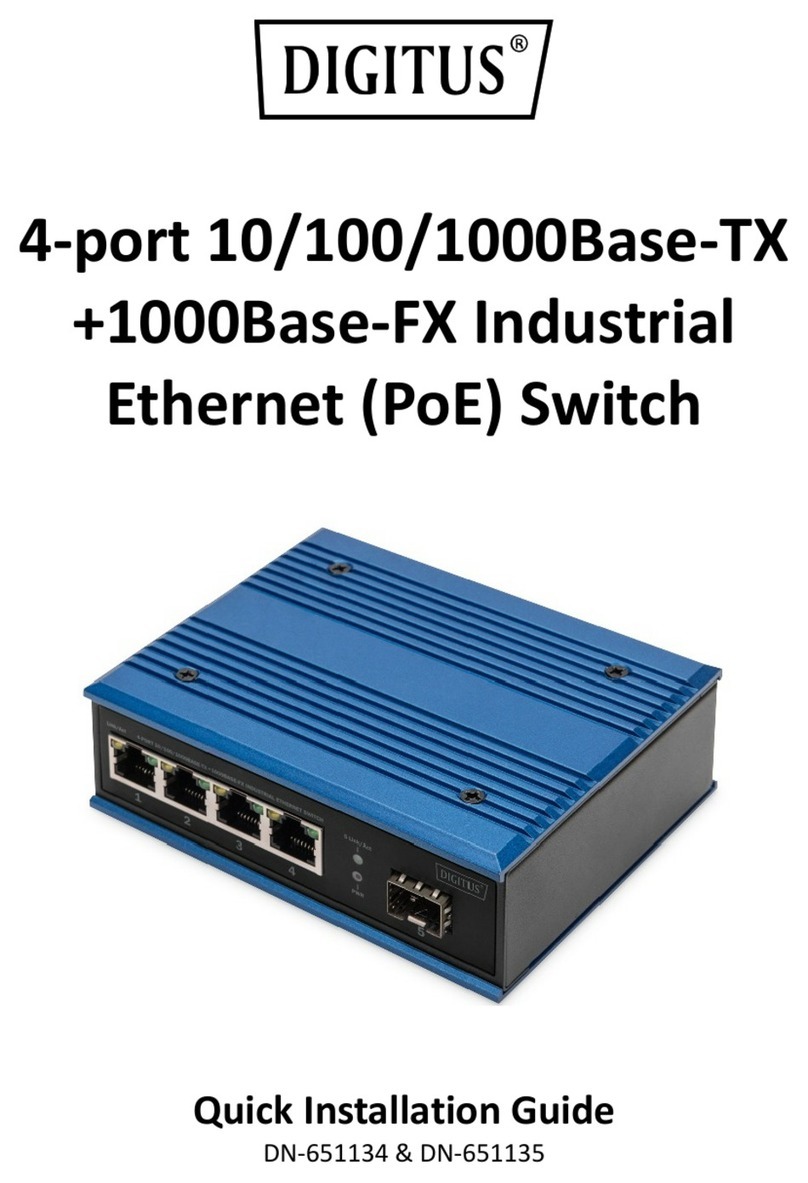
Digitus
Digitus DN-651135 Quick installation guide
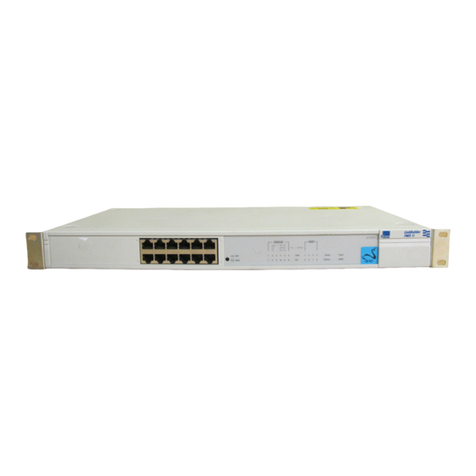
3Com
3Com 3C16670 - LinkBuilder FMS II Hub Configuration guide
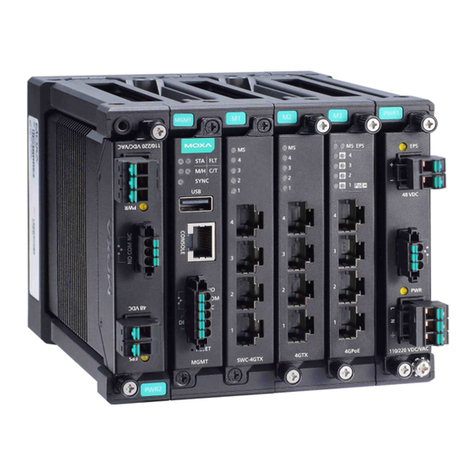
Moxa Technologies
Moxa Technologies MDS-G4000 Series Quick installation guide
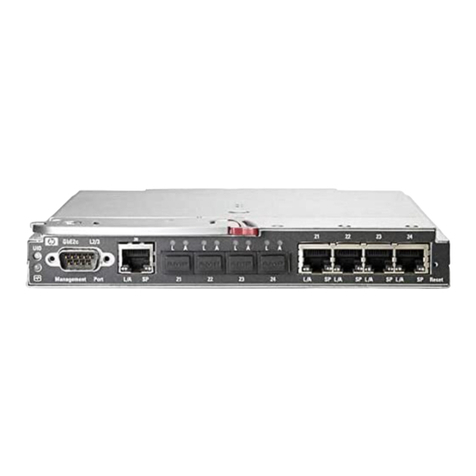
HP
HP GbE2c - Blc Layer 2/3 Fiber SFP Option Command reference guide
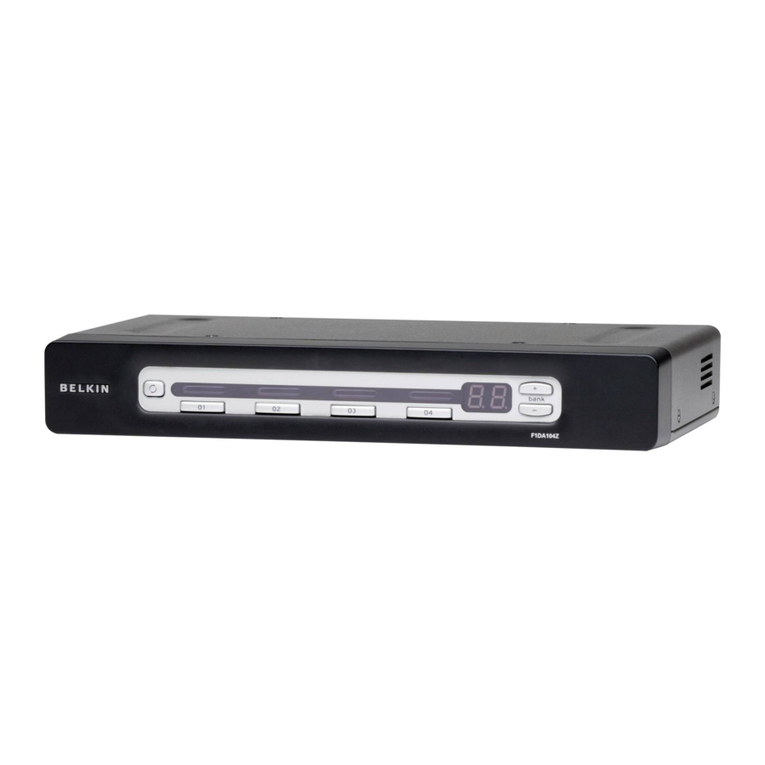
Belkin
Belkin OmniView Dual-User PRO3 Quick installation guide
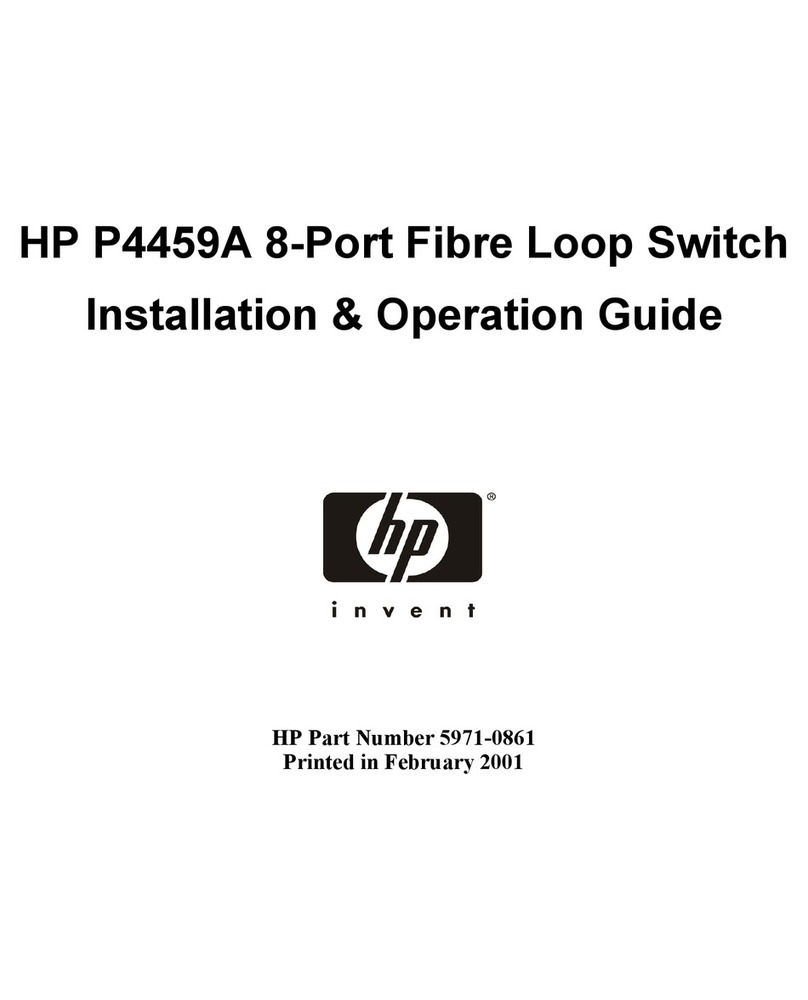
HP
HP P4459A Installation & operation guide
